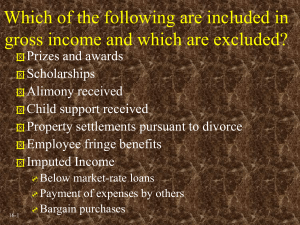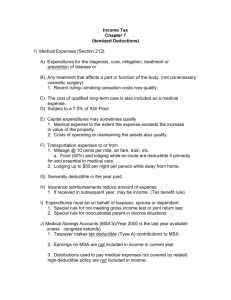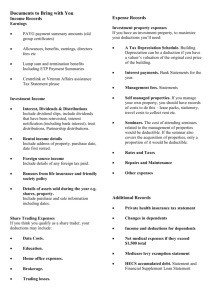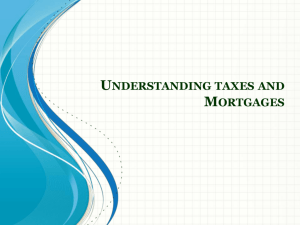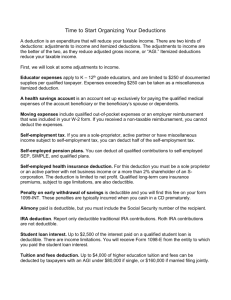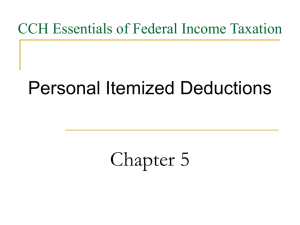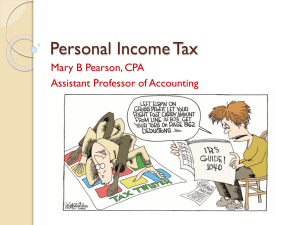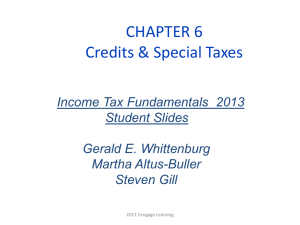1285424549_411384
advertisement
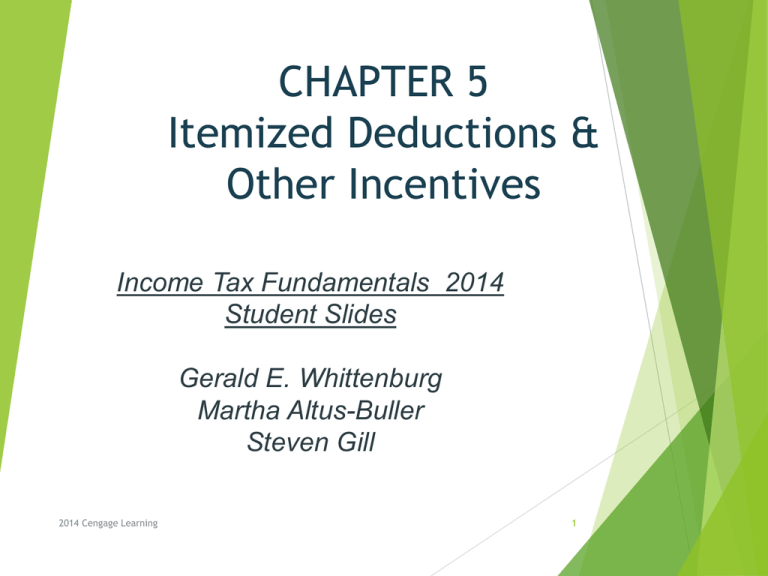
CHAPTER 5 Itemized Deductions & Other Incentives Income Tax Fundamentals 2014 Student Slides Gerald E. Whittenburg Martha Altus-Buller Steven Gill 2014 Cengage Learning 1 Medical Expenses First itemized deduction on Schedule A Medical expenses allowed ◦ For spouse, self and dependents ◦ For amounts spent that exceed 10% of AGI (or 7.5% if single and over 65 or MFJ and one spouse over 65) ◦ Must be reduced by amount of insurance reimbursement See page 5-2 for list of health, dental, and optical expenditures that qualify ◦ Medical insurance premiums (including Medicare) ◦ Long-term care insurance premiums Specified limits that change each year based on taxpayer’s age If deducted for AGI, excluded from Schedule A calculations 2014 Cengage Learning 2 Taxes Deductions for certain taxes are allowed Taxes are deductible, fees are not ◦ Taxes are imposed by a government to raise revenue for general public purposes ◦ Fees are charges with a direct benefit to person paying Examples of deductible taxes ◦ ◦ State and local income taxes (deductible in year paid) Sales/use tax ◦ ◦ ◦ ◦ May use actual sales tax or from IRS-provided tables If actual deduction, must keep receipts for all sales tax paid Real property taxes Personal property taxes Example of nondeductible taxes include estate taxes, gift taxes and excise taxes 2014 Cengage Learning 3 Overview of Interest Interest is amount paid for use of borrowed funds ◦ Borrower must be legally liable for note in order to deduct the interest Examples of deductible interest include ◦ Qualified mortgage interest and points ◦ Mortgage interest prepayment penalties ◦ Investment interest (except if used to generate tax-exempt interest) ◦ Certain interest associated with passive activities Consumer (personal) interest is not deductible Private mortgage insurance (PMI) related to debt acquired to purchase of personal residence deductible if AGI is $100,000 or less 2014 Cengage Learning 4 Contributions Charitable contributions are allowed as a deduction Can contribute cash or property ◦ ◦ Out of pocket expenses are deductible $.14/mile for mileage deduction ◦ Value of free use of taxpayer’s property is not deductible To be deductible, donation must be made to a qualified recipient (see pages 5-12 and 5-13) IRS publishes online search tool called “Exempt Organizations Select Check” 2014 Cengage Learning 5 Casualty and Theft Losses Deductions are allowed for casualty and theft losses To be classified as casualty loss, event needs to be sudden, unexpected or unusual ◦ ◦ If theft, need to prove (for example, by police report) Different calculations for deduction based on what type of property Casualty losses are only deductible in year of occurrence ◦ Exception: for federally declared disaster area losses, taxpayer can amend prior year return and deduct in that year and file for refund 2014 Cengage Learning 6 Miscellaneous Deductions There are two types of miscellaneous deductions “Those not limited to amounts over 2% of AGI” ◦ Handicapped “impairment related work expenses” ◦ Certain estate taxes ◦ Amortizable bond premiums (for bonds purchased prior to 10/23/86) ◦ Gambling losses to extent of gambling winnings ◦ Unrecovered annuity costs at death 2014 Cengage Learning 7 Miscellaneous Deductions “Those limited to amounts over 2% AGI” ◦ Unreimbursed employee expenses (use Form 2106 or 2106-EZ) ◦ Reimbursed employee expenses made under a non-accountable plan ◦ Union dues ◦ Tax preparation fees ◦ Safety deposit box ◦ Professional journals/subscriptions ◦ Investment expenses ◦ Job-hunting fees 2014 Cengage Learning 8 Qualified Tuition Programs (QTP) Sometimes called §529 tuition plans Allows taxpayers to meet higher education expenses by ◦ Buying in-kind tuition credits or certificates or ◦ Contributing to an established account Distributions are generally not taxed if funds used for higher education ◦ Tuition, fees, books, supplies, equipment plus reasonable amount for room and board ◦ Computer technology primarily used for educational purposes ◦ If not used for purposes outlined or the taxpayer withdraws early, then distributions are taxable plus 10% penalty 2014 Cengage Learning 9 Education Savings Accounts These accounts allow taxpayers to meet higher education expenses by contributing to an educational savings account Annual ◦ ◦ ◦ ◦ contributions are not deductible Allowed until beneficiary reaches 18 Limited to $2,000/year per child Can’t make in same year as contribution to QTP Phase-out when AGI exceeds $190,000 (MFJ) or $95,000 (S) 2014 Cengage Learning 10 Phase-Out of Itemized Deductions for High-Income Taxpayers If AGI exceeds following amounts, itemized deductions and exemptions are phased out o Single $250,000 o HOH $275,000 o MFJ $300,000 o MFS $150,000 Itemized deductions reduced by the less of 3% of excess of taxpayer’s AGI over threshold amount or 80% of itemized deductions other than medical expenses, investment interest, casualty/theft and wagering losses that are in excess of wagering gains 2014 Cengage Learning 11 Phase-Out of Exemptions for High-Income Taxpayers Personal and dependency exemptions are reduced by 2% for each $2,500* (or fraction thereof) by which the taxpayer’s AGI exceeds the threshold amounts (prior slide) *Or $1,250 for MFS 2014 Cengage Learning 12
